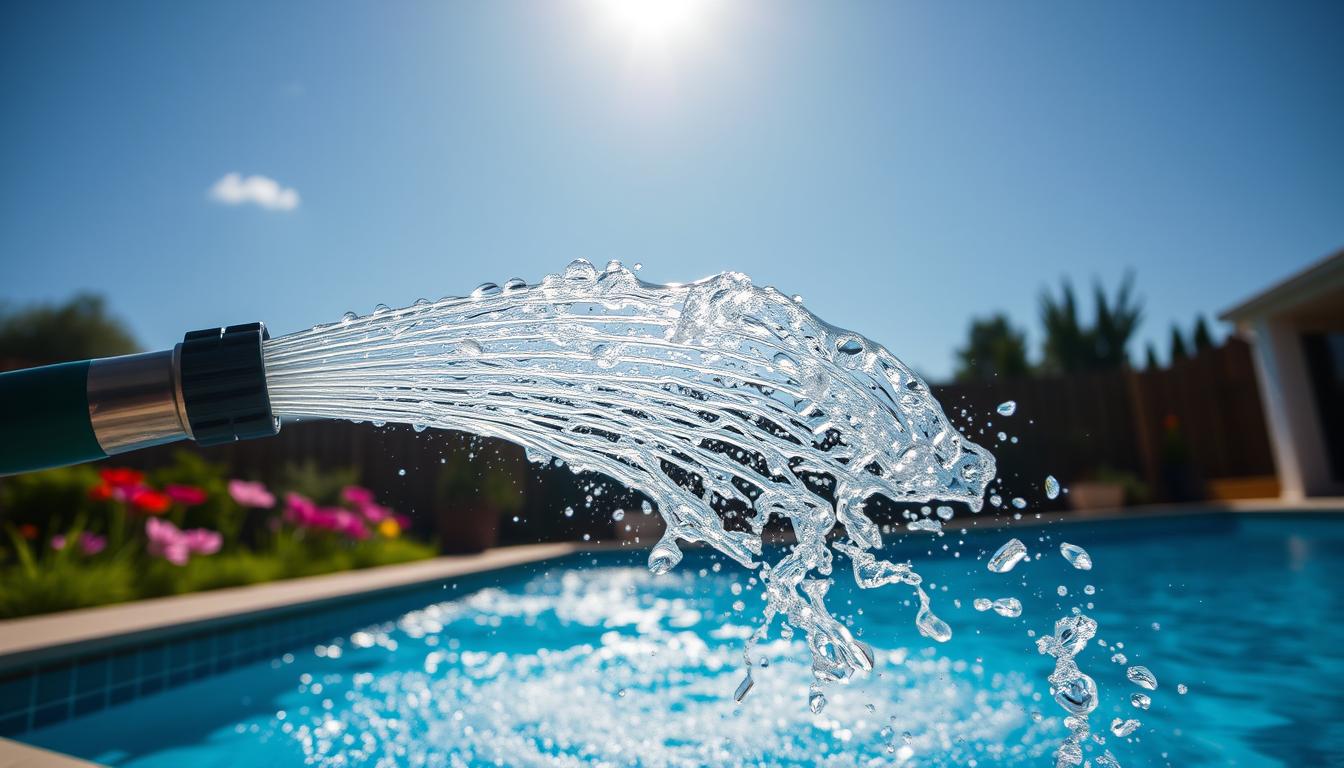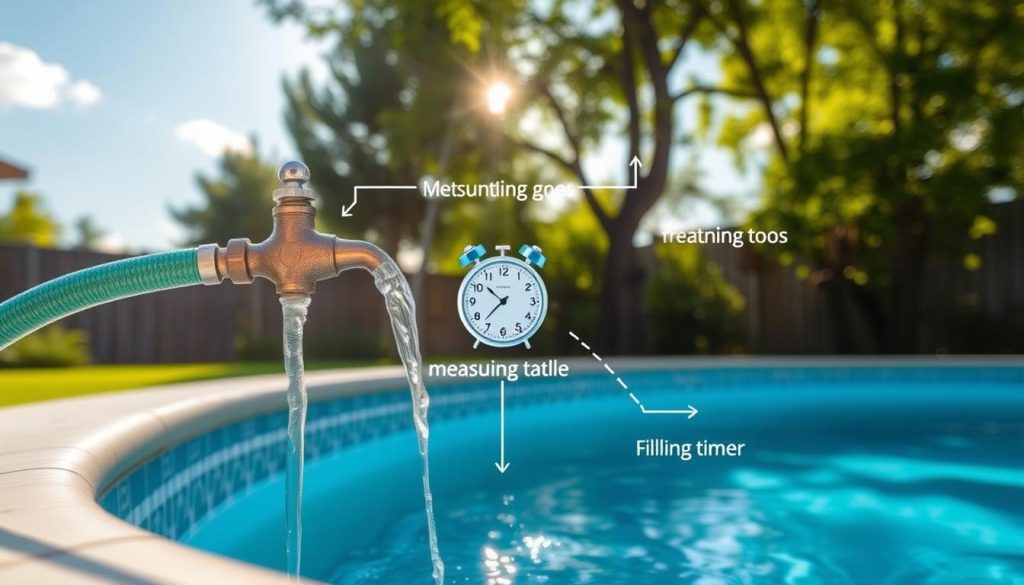
Filling a 10,000-gallon pool with a garden hose costs about $35 in water. That’s much cheaper than the $350 for trucked-in water. This big price difference can help you make smart choices about your pool-filling method.
Understanding pool filling time and costs is crucial for planning your backyard oasis. It can help you make informed decisions about your outdoor water usage.
A garden hose typically delivers 5-10 gallons of water per minute. This flow rate depends on your home’s water pressure. The size of your pool affects how long it takes to fill.
For example, a 20,000-gallon pool usually takes about 24 hours to fill with a garden hose. This assumes average flow rate and steady water supply.
It’s important to compare garden hoses with pool fill lines and water delivery services. Garden hoses are cheaper but take longer and may strain your home’s water supply.
An average household uses about 300 gallons of water daily. Filling a pool can greatly increase your outdoor water usage.
Factors That Affect Pool Filling Time
Several factors impact how long it takes to fill a backyard pool with a garden hose. These elements are key for effective pool maintenance and water conservation.

Pool Size and Capacity
Pool size is the main factor in determining fill time. An average inground pool holds 20,000 to 30,000 gallons of water. It takes about 24 hours to fill a 20,000-gallon pool with a garden hose.
Water Pressure and Flow Rate
Water pressure and flow rate affect pool filling speed. US household water pressure ranges from 40-80 psi. Higher pressure fills pools faster but may increase water bills.
Flow rate is measured in gallons per minute (GPM). A standard garden hose delivers about 9 GPM. Higher GPM results in quicker filling times.
The average flow rate of a garden hose is estimated to be about 5-10 gallons per minute, as per a study conducted by the University of Nebraska-Lincoln.
Hose Diameter and Length
Hose diameter and length impact fill time. A wider hose diameter allows faster filling. A 3/4-inch diameter hose is recommended for quicker filling.
Longer hoses can slow the flow rate due to friction loss. This affects the efficiency of the filling process.
Here’s a table comparing the impact of hose diameter on flow rate and filling time:
| Hose Diameter | Flow Rate (GPM) | Time to Fill 20,000 Gallons |
|---|---|---|
| 1/2 inch | 6-9 | 37-56 hours |
| 5/8 inch | 9-12 | 28-37 hours |
| 3/4 inch | 12-15 | 22-28 hours |
Climate and water source can also affect pool filling time. Hot, dry climates may increase evaporation, extending fill time. Well water may fill slower due to lower pressure.
To optimize pool filling time and save water, try these tips:
- Use a wider diameter hose for faster filling
- Ensure a high water pressure and flow rate
- Minimize hose length to reduce friction loss
- Fill the pool during cooler parts of the day to minimize evaporation
- Monitor the filling process to avoid overfilling and water waste
Understanding these factors helps you manage pool maintenance efficiently. It also promotes responsible water usage for your backyard pool.
Calculating Pool Volume
To fill a pool with a garden hose, we need to know its volume. The pool’s shape and size are key factors. Let’s look at formulas for different pool shapes and online calculators.
Formulas for Different Pool Shapes
Pool volume formulas vary based on the pool’s shape. For rectangular pools, multiply length, width, and depth. Circular or irregular pools need more complex math.
Here are formulas for common pool shapes:
- Rectangular Pool: Volume = Length × Width × Depth
- Circular Pool: Volume = π × Radius² × Depth
- Oval Pool: Volume = π × (Radius 1) × (Radius 2) × Depth
- Irregularly Shaped Pool: Divide the pool into smaller geometric shapes, calculate the volume of each shape, and add them together.
For pools with varying depths, find the average depth. Measure the shallow and deep ends, add them, and divide by two.
Online Pool Volume Calculators
Don’t worry if math isn’t your strong suit. Many online pool volume calculators can help. These tools need your pool’s dimensions to figure out the water volume.
Online calculators save time and boost accuracy for complex pool shapes. Just search for “pool volume calculator” to find user-friendly options.
Let’s look at an example. A 24-foot round pool, 4 feet deep, holds about 13,500 gallons. Using a hose with 5 gallons per minute flow, it would take 45 hours to fill.
| Pool Size | Average Depth | Water Volume | Filling Time (at 5 GPM) |
|---|---|---|---|
| 18′ Round | 4 feet | 7,646 gallons | 25.5 hours |
| 24′ Round | 4 feet | 13,593 gallons | 45.3 hours |
| 30′ Round | 4 feet | 21,240 gallons | 70.8 hours |
When filling your pool, watch the water level closely. Account for evaporation and splashing. Knowing your pool’s volume helps you plan the filling process better.
How Long Does It Take to Fill a Pool with a Garden Hose
Many people use garden hoses to fill their pools for summer fun. Let’s look at pool filling time estimates and the factors involved.
Average Filling Time for Various Pool Sizes
Filling time depends on pool size and hose flow rate. Here are some general estimates for different pool sizes:
| Pool Size | Average Filling Time |
|---|---|
| 12-foot round, 3-feet deep | 2 hours |
| 15-foot round, 4-feet deep | 4-6 hours |
| 18-foot round, 4-feet deep | 6-8 hours |
| 24-foot round, 4-feet deep | 12-18 hours |
| 30-foot round, 6-feet deep | 24-36 hours |
These are rough estimates. Actual filling times can vary based on water pressure and hose diameter. The distance from the water source can also affect filling time.
Real-World Examples and Scenarios
Let’s look at a real example. A 15,000-gallon pool with an 8 gallon-per-minute hose would take about 32 hours to fill.
Well water can take longer, usually 48-72 hours. It’s important to watch the well’s water level to avoid running it dry.
Tip: Water delivery services can quickly fill your pool with pre-treated water. This can save time and money on chemical balancing.
Tips for Faster Pool Filling
Here are some ways to speed up pool filling:
- Use a wider diameter garden hose to increase water flow
- Connect multiple hoses to different water sources
- Ensure optimal water pressure by checking for leaks or kinks in the hose
- Adjust pump and system flow rates to optimize filling time
- For larger pools, consider using high-pressure sources like fire hydrants or tanker trucks (with proper permissions and precautions)
Check for local water shortages before filling your pool. Let’s enjoy summer fun responsibly!
Conclusion
Filling a pool with a garden hose is a common method for pool owners. The time it takes depends on pool size, water pressure, hose diameter, and flow rate. It can take several hours to a few days to fill a backyard pool.
To estimate filling time, calculate your pool’s volume based on its shape and dimensions. Larger pools take longer to fill than smaller ones. Higher water pressure and flow speed up the process. Using a wider hose can increase water flow and reduce filling time.
Other options like water delivery services or fire hydrants can fill pools faster. However, these may cost more. Be mindful of water conservation, especially in drought-prone areas. Monitor water levels and perform routine maintenance to keep your pool in top shape.







